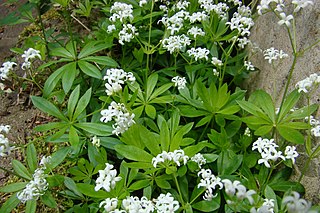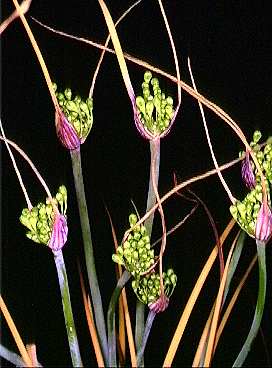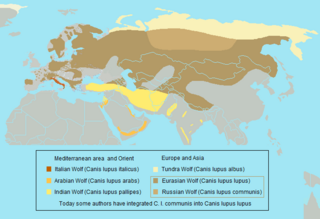A special area of conservation (SAC) is defined in the European Union's Habitats Directive (92/43/EEC), also known as the Directive on the Conservation of Natural Habitats and of Wild Fauna and Flora. They are to protect the 220 habitats and approximately 1,000 species listed in annex I and II of the directive which are considered to be of European interest following criteria given in the directive. They must be chosen from the sites of Community importance by the member states and designated SAC by an act assuring the conservation measures of the natural habitat.

Abies nebrodensis, the Sicilian fir, is a fir native to the Madonie mountains in northern Sicily.

Galium odoratum, the sweet woodruff or sweetscented bedstraw, is a flowering perennial plant in the family Rubiaceae, native to much of Europe from Spain and Ireland to Russia, as well as Western Siberia, Turkey, Iran, the Caucasus, China and Japan. It is also sparingly naturalised in scattered locations in the United States and Canada. It is widely cultivated for its flowers and its sweet-smelling foliage.
The Habitats Directive is a directive adopted by the European Community in 1992 as a response to the Berne Convention. The European Community was reformed as the European Union the following year, but the directive is still recognised.

Desmoulin's whorl snail is a species of minute air-breathing land snail, a terrestrial pulmonate gastropod mollusc or micromollusc in the family Vertiginidae, the whorl snails.

Vertigo angustior, the narrow-mouthed whorl snail, is a species of minute land snail, a terrestrial pulmonate gastropod mollusk or micromollusk in the family Vertiginidae, the whorl snails.

Anthemis glaberrima is a species of flowering plant in the family Asteraceae. It is found only in Greece. Its natural habitats are rocky shores and Mediterranean-type shrubby vegetation.

Helosciadium bermejoi, synonym Apium bermejoi, is a critically endangered species of flowering plant in the family Apiaceae.
Bupleurum kakiskalae is a species of flowering plant in the family Apiaceae. It is endemic to western Crete, an island which is part of Greece.
Naufraga balearica is an extremely rare species of flowering plant in the family Apiaceae, and the only species in the genus Naufraga. It is endemic to the Spanish island of Majorca, where it is found only at the base of cliffs at the north of the island near Pollença. A population was discovered on Corsica in 1981, but it had died out by 1983, and it is not clear whether it arrived naturally. Its natural habitats are Mediterranean-type shrubby vegetation and rocky shores.

Potamogeton gramineus is a species of aquatic plant known by the common name various-leaved pondweed, variableleaf pondweed, grass-leaved pondweed or grassy pondweed, native to the northern hemisphere where it grows in shallow, clean water.

Leopoldia gussonei is a plant in the family Asparagaceae, endemic to the Island of Sicily.

Allium nebrodense is a rare Italian species of wild onion. It is found only on the Island of Sicily in southern Italy.

Centaurea horrida is a species of the genus Centaurea which is only found growing in Sardinia and associated islands. Due to their limited ability to disperse, they are isolated from other environments, and have a very low colonizing ability.
Allium permixtum is an Italian species of wild onion native to Sicily and Abruzzo, though it is most likely extinct in Sicily.
Daphne rodriguezii is a shrub, of the family Thymelaeaceae. It is endemic to Menorca, one of the Balearic Islands that belongs to Spain.

Juniperus turbinata is a woody plant in the family Cupressaceae.

Diuris pedunculata, commonly known as the small snake orchid, is a species of orchid which is endemic to New South Wales. It usually has two leaves at its base and one or two yellow and orange flowers with purple markings. It originally occurred in scattered populations between Tenterfield and the Hawkesbury River but because of habitat loss is now only known from the New England Tableland.

The biogeographic regions of Europe are biogeographic regions defined by the European Environment Agency. They were initially limited to the European Union member states, but later extended to cover all of Europe west of the Urals, including all of Turkey. The map of biogeographic regions is deliberately simplified and ignores local anomalies. It is intended primarily as a framework for coordinating and reporting overall results of conservation efforts.

The favourable conservation status of wolves is the definition of a wolf population that is no longer threatened with extinction, that is capable of long-term survival. In Europe the favourable conservation status is defined by the Guidelines for Population Level Management Plans for Large Carnivores. It is the minimum viable population, that can be of different numbers of wolves depending on their connectivity with neighbouring populations. According to the IUCN guidelines, at least 1000 adult animals are required for isolated populations. If a wolf population is effectively linked genetically and demographically with other wolf populations, more than 250 mature wolves may be sufficient.















